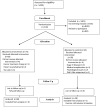Impact of a walking intervention on cardiorespiratory fitness, self-reported physical function, and pain in patients undergoing treatment for solid tumors
- PMID: 19637345
- PMCID: PMC2761503
- DOI: 10.1002/cncr.24551
Impact of a walking intervention on cardiorespiratory fitness, self-reported physical function, and pain in patients undergoing treatment for solid tumors
Erratum in
- Cancer. 2013 May 1;119(9):1762
Abstract
Background: Cancer treatment is associated with decline in measured and self-reported physical function and increased pain. In the current study, the authors evaluated the impact of a walking intervention on these outcomes during chemotherapy/radiation.
Methods: Patients with breast, prostate, and other cancers (N=126) were randomized to a home-based walking intervention (exercise) or usual care (control). Exercise dose during the intervention was assessed using a 5-item Physical Activity Questionnaire. Outcome measures were cardiorespiratory fitness, expressed as peak oxygen uptake (VO2) measured during treadmill testing (n=85) or estimated by 12-minute walk (n=27), and self-reported physical function, role limitations, and pain derived from Medical Outcomes Study Short Form 36. Linear regression was used to evaluate pre-to-post intervention change outcomes between groups.
Results: The mean (standard deviation) age of the patients was 60.2 (10.6) years. Diagnoses included prostate (55.6%) and breast (32.5%) cancer. Treatment included external beam radiotherapy (52.3%) and chemotherapy (34.9%). Exercise patients reported worsening Medical Outcomes Study physical function role limitations by the end of cancer treatment (P=.037). Younger age was associated with improved Medical Outcomes Study physical function (P=.048). In all patients, increased exercise dose was associated with decreased Medical Outcomes Study pain (P=.046), regardless of diagnosis. The percent change of VO2 between prostate and nonprostate cancer patients when adjusted for baseline VO2 and Physical Activity Questionnaire values was 17.45% (P=.008), with better VO2 maintenance in the prostate group.
Conclusions: Exercise during cancer treatment improves cardiorespiratory fitness and self-reported physical function in prostate cancer patients and in younger patients, regardless of diagnosis, and may attenuate loss of those capacities in patients undergoing chemotherapy. Exercise also reduces the pain experience.
Copyright (c) 2009 American Cancer Society.
Figures
References
-
- Vogelzang NJ, Breitbart W, Cella D, et al. Patient, caregiver, and oncologist perceptions of cancer-related fatigue: results of a tripart assessment survey. The Fatigue Coalition. Semin Hematol. 1997 Jul;34(3 Suppl 2):4–12. - PubMed
-
- Ness KK, Wall MM, Oakes JM, Robison LL, Gurney JG. Physical performance limitations and participation restrictions among cancer survivors: a population-based study. Ann Epidemiol. 2006 Mar;16(3):197–205. - PubMed
-
- Sweeney C, Schmitz KH, Lazovich D, Virnig BA, Wallace RB, Folsom AR. Functional limitations in elderly female cancer survivors. J Natl Cancer Inst. 2006 Apr 19;98(8):521–529. - PubMed
-
- Thorsen L, Dahl AA, Skovlund E, Hornslien K, Fossa SD. Effectiveness after 1 year of a short-term physical activity intervention on cardiorespiratory fitness in cancer patients. J Clin Oncol. 2007 Apr 1;25(10):1301–1302. - PubMed
-
- Schneider CM, Hsieh CC, Sprod LK, Carter SD, Hayward R. Effects of supervised exercise training on cardiopulmonary function and fatigue in breast cancer survivors during and after treatment. Cancer. 2007 Aug 15;110(4):918–925. - PubMed


